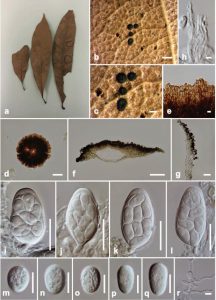Muyocopron lithocarpi Mapook, Boonmee & K.D. Hyde, sp. nov., Index Fungorum number: IF 551618
Etymology: Named after the host genus Lithocarpus, from which this species was collected.
Holotype: MFLU 15–1133
Saprobic on dead leaves of Lithocarpus lucidus (Roxb.) Rehder. Sexual morph: Ascomata 40–70(–120) µm high× 220–320 µm diam. (x̅ = 69 × 262 µm, n = 5), superficial, coriaceous, solitary or scattered, appearing as circular, scattered, flattened, brown to dark brown spots, covering the host, without a subiculum, with a poorly developed basal layer and an irregular margin. Ostiolar central. Peridium 10–20(–28) µm wide, widest at the sides, outer layer comprising dark brown to black pseudoparenchymatous, occluded cells of textura epidermoidea, inner layer comprising light brown cells of textura angularis. Hamathecium comprising 1.5–2.5 µm wide, cylindrical to filiform, septate, pseudoparaphyses. Asci 45–65 × (15–)23–28 µm (x̅ = 54.5 × 25 µm, n = 20), 8-spored, bitunicate, saccate or broadly obpyriform, pedicellate, straight or slightly curved, with small ocular chamber. Ascospores 13–18 × 9–11 µm (x̅ = 15.5 × 10 µm, n = 20), irregularly arranged, overlapping in the ascus, hyaline, oval to obovoid with obtuse ends, aseptate, with granular appearance. Asexual morph: Undetermined.
Culture characteristics: Ascospores germinating on MEA within 24 hr. at room temperature and germ tubes produced from the ends of the ascospore. Colonies on MEA reaching 1.2 cm diam for 1 week, at 25 oC. Initially aerial mycelium white, slightly raised, in old cultures grayish to light brown, flattened on surface, brown to dark brown from below, light brown to white margin.
Material examined: THAILAND, Chiang Rai, on fallen leaves of Lithocarpus lucidus (Fagaceae). 30 September 2014, A. Mapook (MFLU 15–1133, holotype), living culture MFLUCC 14–1106, BCC; ibid. (HKAS92524, isotype); on fallen leaves of Lithocarpus lucidus (Fagaceae), 30 September 2014, A. Mapook (MFLU 16-0477, paratype).
Notes: Muyocopron lithocarpi was isolated from fallen leaves of Lithocarpus lucidus in Chiang Rai and the general morphology is similar to Muyocopron umbilicatum Speg., especially in the shape and size of asci and ascospores (Table 2) but differs in host family and continent and in the mean size of the ascospores (15.5 × 10 µm vs 18 × 11 µm). Therefore we introduce a new species based on morphology.
Fig. 4. Muyocopron lithocarpi (holotype). a–c Superficial ascomata on substrate. d–e Squash mounts showing ascomata walls. f Section of ascoma. g Peridium. h Pseudoparaphyses. i–l Asci. m–q Unicellular ascospores. r Germinating ascospore. Scale bars: b = 500 µm, c = 200 µm, d = 100 µm, f–g = 50 µm, i–l = 20 µm, m–r = 10 µm, e, h = 5 µm.

